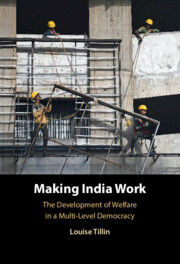Book contents
- Making India Work
- Making India Work
- Copyright page
- Dedication
- Contents
- Illustrations
- Acknowledgments
- Abbreviations
- 1 Introduction
- 2 Origins, Expansion, and Reform
- Part I Building a National Economy: Regulating Internal Competition
- Part II Putting India to Work
- Part III Liberalisation and Welfare in a Multi-level Democracy
- 7 Liberalisation and the ‘Social Safety Net’
- 8 Welfare, Rights, and the Market in the Post-Congress Polity, 1998–2014
- 9 Conclusion
- Bibliography
- Index
8 - Welfare, Rights, and the Market in the Post-Congress Polity, 1998–2014
from Part III - Liberalisation and Welfare in a Multi-level Democracy
Published online by Cambridge University Press: 13 February 2025
- Making India Work
- Making India Work
- Copyright page
- Dedication
- Contents
- Illustrations
- Acknowledgments
- Abbreviations
- 1 Introduction
- 2 Origins, Expansion, and Reform
- Part I Building a National Economy: Regulating Internal Competition
- Part II Putting India to Work
- Part III Liberalisation and Welfare in a Multi-level Democracy
- 7 Liberalisation and the ‘Social Safety Net’
- 8 Welfare, Rights, and the Market in the Post-Congress Polity, 1998–2014
- 9 Conclusion
- Bibliography
- Index
Summary
This chapter explores a double shift in social policy from the late 1990s to the mid 2010s. Firstly, under the Atal Behari Vajpayee-led NDA governments (1998-99; 1999-2004) contributory social insurance was extended to reach labour market ‘outsiders’, who worked in the informal sector without access to the social insurance enjoyed by formal sector workers. This policy shift was intended to support wider labour law reforms by sidelining the political power of organised labour. As the sustainability of India’s new economic model came under scrutiny, a second shift took place under the Congress-led UPA government (2004-14) in which non-employment-linked social assistance programmes were recognised for the first time - at least in theory - as permanent, statutory rights or entitlements of citizenship. The chapter ends by examining the centrality of states to social policy implementation. It shows that by 2014 the typical subnational welfare regime combined high levels of labour commodification with publicly financed social assistance. This reflected the embrace of labour informalisation on the one hand, and the provision of direct, publicly financed social assistance on the other.
Keywords
- Type
- Chapter
- Information
- Making India Work , pp. 173 - 192Publisher: Cambridge University PressPrint publication year: 2025

